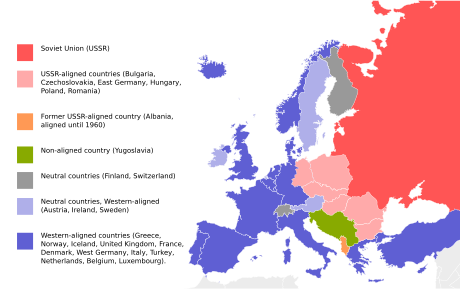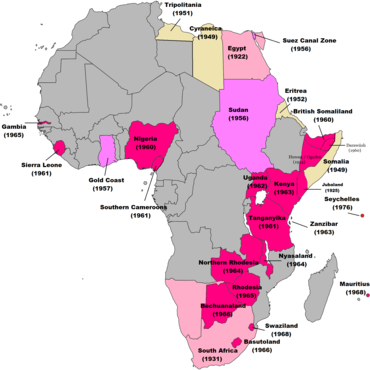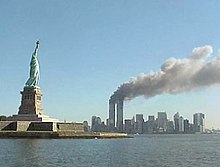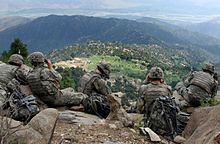Contemporary history
This article needs additional citations for verification. (August 2023) |
| Part of a series on |
| Human history Human Era |
|---|
| ↑ Prehistory (Stone Age) (Pleistocene epoch) |
| ↓ Future |
Contemporary history, in English-language
Contemporary history is
Science made new advances after 1945: spaceflight, nuclear technology, lasers, semiconductors, molecular biology, genetics, particle physics, and the Standard Model of quantum field theory. The first commercial computers were created, followed by the Internet, beginning the Information Age.
Political history
1945–1991

In 1945, the Allies of World War II had defeated all significant opposition to them. They established the United Nations to govern international relations and disputes. A looming question was how to handle the defeated Axis nations and the shattered nations that the Axis had conquered. Following the Yalta Conference, territory was divided into zones for which Allied country would have responsibility and manage rebuilding. While these zones were theoretically temporary (such as the eventual fate of occupied Austria, which was released to independence as a neutral country), growing tensions between the Western Bloc, led by the United States, with the Eastern Bloc, led by the Soviet Union, meant that many calcified into place. Countries in Soviet zones of Eastern Europe had communist regimes installed as satellite states. The Berlin Blockade of 1948 led to a Western Airlift to preserve West Berlin and signified a cooling of East-West relations. Germany split into two countries in 1949, liberal-democratic West Germany and communist East Germany. The conflict as a whole would become known as the Cold War. The Western Bloc formed NATO in 1949 while the Eastern Bloc formed the Warsaw Pact in 1955. Direct combat between the new Great Powers was generally avoided, although proxy wars fought in other countries by factions equipped by one side against the other side's faction occurred. An arms race to develop and build nuclear weapons happened as policymakers wanted to ensure their side had more if it came to a war.[2]
In East Asia,
The Middle East became a hotbed of instability. The new Jewish state of

In Africa, France fought the grinding Algerian War from 1954–1962 that saw the end of French Algeria and the rise of a new independent Algeria. The British and French both slowly released their vast holdings, leading to the creation of states such as First Nigerian Republic in 1963. Portugal, on the other hand, fiercely held onto their Empire, leading to the Portuguese Colonial War from 1961–1974 in Angola, Guinea-Bissau, and Mozambique until the Estado Novo government fell. Meanwhile, apartheid-era South Africa remained fiercely anti-communist, but withdrew from the British Commonwealth in 1961, and supported various pro-colonial factions across Africa that had lost support from their "home" governments in Europe. Many of the newly independent African governments struggled with the balance between being too weak and overthrown by ambitious coup-plotters, and too strong and becoming dictatorships.
Latin America saw gradual economic growth but also instability in many countries, as the threat of coups and military regimes (juntas) were a major threat. The most famous was the Cuban Revolution that overthrew Fulgencio Batista's American-friendly government for Fidel Castro's Soviet-aligned government. This led to the Cuban Missile Crisis in 1963, generally considered one of the incidents most dangerously close to turning the Cold War into a direct military conflict. The 1968 Peruvian coup d'état and also installed a Soviet-friendly government. Despite this, the region ultimately leaned toward the US in this period, with the CIA supporting American-friendly factions in the 1954 Guatemalan coup d'état, the 1964 Brazilian coup d'état, the 1973 Chilean coup d'état, and others. Nicaragua suffered the most, with the Nicaraguan Revolution seeing major military aid from both great powers to their favored factions that extended a civil war in the country for decades. Mexico escaped this unrest, although functioned largely as a one-party state dominated by the PRI. Argentina had a succession of idiosyncratic governments that courted both the US and USSR, but generally mismanaged the economy.
The Middle East saw events that presaged later conflicts in the 70s and 80s. A few years after the end of the UAR's union between Egypt and Syria, Syria's government was overthrown in the
In East Asia, China underwent the Cultural Revolution from 1966 to 1976, a major internal struggle that saw an intense program of Maoism and persecution of perceived internal enemies. China's relations with the Soviets deteriorated in the 1960s and 70s, resulting in the Sino-Soviet split, although the two were able to cooperate on some matters. "Ping-pong diplomacy" led to a rapprochement between the US and China and American recognition of the Chinese communist government in the 1970s. China's pro-democracy movement was suppressed after the 1989 Tiananmen Square protests, and China's government survived the tensions that would roil the Soviet-aligned bloc during the 1980s. South Korea (in the June Democratic Struggle) and Taiwan (with the lifting of martial law) would take major steps toward liberalization in 1987–1988, shifting from Western-aligned one-party states to more fully participatory democracies.
The 1980s saw a general retreat for the communist bloc. The
1991–2001
The end of the Cold War left the United States the world's sole superpower. Communism seemed discredited; while China remained an officially communist state, Deng Xiaoping's economic reforms and socialism with Chinese characteristics allowed for the growth of a capitalist private sector in China. In Russia, President Boris Yeltsin pursued a policy of privatization, spinning off former government agencies into private corporations, attempting to handle budget problems inherited from the USSR. The end of Soviet foreign aid caused a variety of changes in countries previously part of the Eastern Bloc; many officially became democratic republics, though some were more accurately described as authoritarian or oligarchic republics and one-party states.[4] Many Western commentators treated the development optimistically; it was thought the world was steadily progressing toward free, liberal democracies. South Africa, no longer able to attract Western support by claiming to be anti-communist, ended apartheid in the early 1990s, and many Eastern European countries switched to stable democracies. While some Americans had anticipated a "peace dividend" from budget cuts to the Defense Department, these cuts were not as large as some had hoped. The European Economic Community evolved into the European Union with the signing of the Maastricht Treaty in 1993, which integrated Europe across borders to a new degree. International coalitions continued to have a role; the Gulf War saw a large international coalition undo Baathist Iraq's annexation of Kuwait, but other "police" style actions were less successful. Somalia and Afghanistan descended into long, bloody civil wars for almost the entirety of the decade (Somali Civil War, Afghan Civil War (1992–1996), Afghan Civil War (1996–2001)). Russia fought a brutal war in Chechnya that failed to suppress the insurgency there from 1994–1996; war would resume during the Second Chechen War in 1999–2000 that saw a resumption of Russian control after Russia successfully convinced enough rebels to join their cause with promises of autonomy. The breakup of Yugoslavia also led to a series of Yugoslav Wars; NATO eventually intervened in the Kosovo War. In the Middle East, the Israeli–Palestinian peace process offered the prospect of a long-term peace deal to many; the Oslo Accords signed in 1993 seemed to offer a "roadmap" to resolving the conflict. Despite these high hopes, they would be largely dashed in 2000–2001 after a breakdown of negotiations and the Second Intifada.
2001–present
War on Terror, Afghanistan War, and Iraq War

The
In response, the United States under President George W. Bush enacted the Patriot Act. Many other countries also strengthened their anti-terrorism legislation and expanded law enforcement powers. Major terrorist events after the September 11 attacks include the Moscow theater hostage crisis, the 2003 Istanbul bombings, the 2004 Madrid train bombings, the Beslan school siege, the 2005 London bombings, the 2005 Delhi bombings, and the 2008 Mumbai attacks, generally from Islamic terrorism.

The United States responded to the 11 September 2001 attacks by launching a "Global War on Terrorism", invading the Islamic Emirate of Afghanistan to depose the Taliban, who had harbored al-Qaeda terrorists. The War in Afghanistan began in late 2001 and was launched by the UN-authorized ISAF, with the United States and United Kingdom providing most of the troops. The Bush administration policy and the Bush Doctrine stated forces would not distinguish between terrorist organizations and nations or governments that harbor them. Operation Enduring Freedom (OEF) was the United States combat operation involving some coalition partners and operating primarily in the eastern and southern parts of the country along the Pakistan border; the ISAF established by the United Nations Security Council was in charge of securing the capital of Kabul and its surrounding areas. NATO assumed control of ISAF in 2003.
Despite initial coalition successes, the Taliban were never entirely defeated, and continued to hold territory in mountainous regions as well as threaten the new government, the Islamic Republic of Afghanistan, whose grasp on power outside the major cities was shaky at best.[7][8] The war was also less successful in restricting al-Qaeda than anticipated.[9]
The
The
In 2011, the United States declared a
Arab Spring and Syria
The
Russia
Economic history
The end of World War II in 1945 saw an increase in
The 1970s saw economic headwinds. Notably, the
In the beginning of the 2000s, there was a global rise in prices in
The

From late 2009
Social history
Social changes since 1945 have been vast and disparate, affecting countries and subgroups within those countries in ways specific to each population, meaning there is not one single global story of social change. Despite this, one of the major trends has been an increasing interchange between cultures and a wider spread of the most successful works, enabled by new technology and globalization. In earlier periods, a successful musician or theater troupe might be confined to playing in a single city at a time, limiting their reach. The spread of better recording technology, such as the magnetophon, meant that a musical act could have their song be played over the radio everywhere without loss of sound quality, creating international superstars such as Elvis Presley and The Beatles. The spread of home television sets allowed people across the globe to easily watch the same show, rather than requiring viewers to attend a local theater. Hollywood in California produced films that dominated cinema; while intended for the lucrative American market, these films spread across the globe, backed by their large budgets and the cinematic expertise gathered there. The rise of the Internet in the 1990s allowed both for an ever further spread of the most popular and dominant works, but the comparatively cheap cost of publishing there, whether as a personal website, blog, or YouTube video, also allowed specific niche subcultures to connect and thrive in a way that was less true in the 20th century. For example, diaspora groups of immigrants can more easily stay in contact with their family and friends in their origin region, compared to earlier eras where travel and communication was far more expensive, making a narrative of strictly increasing global homogenization incomplete. International telephone networks, and later Internet telephony, allowed cheaper and easier long-distance communication than previous eras.
Language usage in the contemporary era has seen a rise in
Religious trends have been disparate and not consistent across countries, often with sharply varying results even between similar and nearby groups. In industrialized and economically prosperous regions, there has been a loose trend toward
Another social trend has been the rise of
A major trend in many industrialized nations was the
One of the yet evolving and unknown impacts in the contemporary era has been the social effects of cheap and common Internet access. As users gradually switched from personal web pages to blogs to social media, many surprising effects have resulted with both positive and negative assessments. Optimistic assessments often praise the decentralized nature that allows anyone to theoretically gain a platform without the need to convince a publisher or media company to back them, as well as the ease in enabling like-minded people to collaborate at long-distance, even if the digital utopianism of the 1990s is less common. Pessimistic assessments worry about the effects on children such as enabling cyberbullying; filter bubbles where Internet users are not challenged by outsider views; "cancel culture" where people are pilloried online but sometimes disproportionately; and slacktivism as an appealing but ineffective replacement for older forms of community work.
Contemporary science and technology
Energy
The growing world population and rising standards of living has caused a vast increase in demand for energy development, both to power vehicles such as personal cars as well as on public electrical grids. In particular, petroleum oil has been in ravenous demand across the world. Many of the cheapest and easiest sources of oil to access were largely drained in the 19th and early 20th centuries, leading to a hunt for new sources of oil. The value of oil has spilled over into politics as well, as "petrostates" with access to oil found a source of vast revenue that did not require traditional government revenue-raising measures, such as tariffs or income taxation. The rising cost of oil led to the 1970s energy crisis and various adaptations in energy conservation to better conserve oil, such as more efficient engines and better insulation. It has also led to concerns of "peak oil," that the rising extraction costs of oil will eventually lead to massive shortages and a large disincentive to burn oil except when absolutely necessary (such as in the case of aviation fuel), although oil continues to be one of the most popular sources of energy.
Other
An entirely new form of energy creation dawned in the 1950s and 1960s:
Various forms of
Computing and the Internet

The
During the late 1990s, both
"
With the rise of
Space exploration
The Space Race was one of the rivalries of the Cold War, with both the United States space program (NASA) and the Soviet space program launching satellites, probes, and planning missions. While the Soviets put the first human into space with Yuri Gagarin, the Americans soon caught up, and the US was the first to launch a successful Moon landing mission with Apollo 11 in 1969, followed by five more landings in the next few years.
In the 1970s and 80s, the US took a new approach with the Space Shuttle program, hoping to reduce the cost of launches by creating a re-usable Space Shuttle. The first fully functional Space Shuttle orbiter was Columbia (designated OV-102), launched into low Earth orbit in April 1981. In 1996, Shuttle mission STS-75 conducted research in space with the electrodynamic tether generator and other tether configurations. The program suffered from two incidents that destroyed a shuttle: the Challenger disaster and the Columbia disaster). The program ultimately had 135 missions. The retirement of NASA's Space Shuttle fleet took place from March to July 2011.
The end of the Cold War saw a new era of international cooperation with the
There are
NASA announced in 2011 that its
Emerging technologies
Various emerging technologies, the recent developments and convergences in various fields of technology, hold possible future impacts. Emerging technologies cover various cutting-edge developments in the emergence and convergence of technology, including transportation, information technology,
Challenges and problems
Climate change
It usually is impossible to connect specific weather events to human impact on the world. Instead, such impact is expected to cause changes in the overall distribution and intensity of weather events, such as changes to the frequency and intensity of heavy precipitation. Broader effects are expected to include
Health and pandemics
Several disease outbreaks, epidemics, and pandemics have occurred during contemporary history. Some of these include the 1957–1958 influenza pandemic, the Hong Kong flu of 1968–1969, the 1977–1979 Russian flu, the HIV/AIDS epidemic (1981–present), the SARS outbreak of 2002–2004, the swine flu pandemic of 2009–2010, and the COVID-19 pandemic (2019–present).
COVID-19 pandemic
In 2020, an outbreak of the COVID-19 disease, first documented in late 2019 in Wuhan, China, spread to other countries becoming a global pandemic, which caused a major socio-economic disruption all over the world. Many countries ordered mandatory lockdowns on movement and closures of non-essential businesses.[41] The threat of the disease caused the COVID-19 recession, although the distribution of vaccines has since eased the economic impact in many countries.
More generally, COVID-19 has been held up as an example of a global catastrophic risk unique to the modern era's ease of travel. New diseases can spread far faster and further in the contemporary era than any previous era of human history; pandemic prevention is one resulting field to ensure that if this happens with a sufficiently deadly virus, humanity can take measures to stop its spread.
Forecasting the future
Contemporary history is fertile ground for creating and testing models of the
Charts
Timeline

Contemporary world map
See also
- General
- Generations
- Generation Y, Generation Z, Generation Alpha
- Music and arts
- Urban contemporary, Video games
References
- ISBN 9780719048364.
- ^ Gaddis 2005, p. 33-60
- ^ Gaddis 2005, p. 237-257
- ^ Steven Levitsky, Lucan A. Way. Competitive Authoritarianism: Hybrid Regimes After the Cold War. 2010. Pg 3.
- ^ "Security Council Condemns, 'In Strongest Terms', Terrorist Attacks on the United States". United Nations. 12 September 2001. Retrieved 11 September 2006.
- ^ "Bin Laden claims responsibility for 9/11". CBC News. 29 October 2004. Retrieved 11 January 2009.
- ^ "The Taliban Resurgence in Afghanistan". Archived from the original on 27 September 2006. Retrieved 9 July 2009.
- ^ "Afghanistan could return to being a 'failed State,' warns Security Council mission chief". 22 November 2006.
- ISBN 978-81-7049-306-8.
- ^ "US Names Coalition of the Willing". BBC News. 18 March 2003. Retrieved 3 November 2007.
- ^ U.S. Defense Secretary Robert Gates, 2 Feb 2007 Archived 30 November 2009 at the Wayback Machine, see "four wars" remark
- ^ "CBS on civil war". CBS News. 26 September 2006.
- ^ "Agreement Between the United States of America and the Republic of Iraq On the Withdrawal of United States Forces from Iraq and the Organization of Their Activities during Their Temporary Presence in Iraq" (PDF). Archived from the original (PDF) on 25 March 2009. Retrieved 9 July 2009.
- ^ Mazzetti, Mark; Cooper, Helene; Baker, Peter (3 May 2011). "Clues Gradually Led to the Location of Osama bin Laden". The New York Times. Retrieved 4 May 2011.
- ^ "US flag ceremony ends Iraq operation". BBC News. 15 December 2011. Retrieved 15 December 2011.
- ^ "US lowers flag to end Iraq war". Associated Press. 15 December 2011. Retrieved 15 December 2011.
- ^ Mak, Tim (15 December 2011). "Leon Panetta marks end of Iraq war". Politico. Retrieved 15 December 2011.
- ^ This American Life. "NPR-The Giant Pool of Money-April 2009". Pri.org. Archived from the original on 15 April 2010. Retrieved 1 May 2010.
- ^ In December 2008, the National Bureau of Economic Research (NBER) declared that the United States had been in recession since December 2007. See Isidore, Chris (1 December 2008). "It's official: Recession since December '07". CNN. Retrieved 10 April 2009. for more information.
- ^ Hulbert, Mark (15 July 2010). "It's Dippy to Fret About a Double-Dip Recession".
- ^ Mishkin, Fredric S. (15 May 2008). How Should We Respond to Asset Price Bubbles? (Speech). Retrieved 18 April 2009.
- ^ Wessel, David (8 April 2010). "Did 'Great Recession' Live Up to the Name?". The Wall Street Journal.
- JSTOR 25063204.
- .
- ^ Soble, Jonathan (23 August 2015). "A Sprawl of Ghost Homes in Aging Tokyo Suburbs". The New York Times. Retrieved 27 February 2016.
- ^ "COP27: Why South Africa will struggle to wean itself off coal". BBC News. 8 November 2022. Archived from the original on 14 December 2022. Retrieved 14 December 2022.
- ^ Alderman, Liz (15 November 2022). "As Europe Quits Russian Gas, Half of France's Nuclear Plants Are Off-Line". The New York Times.
- ^ "Core Characteristics of Web 2.0 Services". 28 November 2008.
- ^ "Total mobile subscribers top 1.8 billion". MobileTracker Cell Phone News and Reviews. 18 May 2005. Archived from the original on 19 January 2008. Retrieved 31 December 2008.
- edge of space at 100 km (62 mi) Earth's altitude. See also: Turbopause; Low, Medium, and High Earth orbit.
- ^ There are many different methods, in conventional and unconventional propulsion systems. Each method has drawbacks and advantages, and spacecraft propulsion is an active area of research. However, most spacecraft today are propelled by forcing a gas from the back/rear of the vehicle at very high speed through a supersonic de Laval nozzle. This sort of engine is called a rocket engine.
- ^ "Higgs boson-like particle discovery claimed at LHC". BBC News. 4 July 2012. Archived from the original on 31 July 2018. Retrieved 21 June 2018.
- ^ "Climate Change 2001: Impacts, Adaptation and Vulnerability. Contribution of Working Group II to the Third Assessment Report of the Intergovernmental Panel on Climate Change". IPCC. 16 February 2001. Archived from the original on 3 March 2007. Retrieved 14 March 2007.
- S2CID 11220212.
- ^ Macey, Jennifer (19 September 2007). "Global warming opens up Northwest Passage". ABC News. Retrieved 11 December 2007.
- ^ "Climate Change 2007: Synthesis report" (PDF). IPCC. 5 February 2007. Retrieved 3 February 2009.
- ^ European Space Agency, "News: Satellites Witness Lowest Arctic Ice Coverage in History," 14 September 2007.
- ^ "Warming 'opens Northwest Passage'". BBC News. 14 September 2007.
- ^ BBC News "Plain Sailing on the Northwest Passage"
- ^ Keating, Joshua E. (December 2009). "The Top 10 Stories You Missed in 2009: A few ways the world changed while you weren't looking". Foreign Policy. Archived from the original on 7 September 2014. Retrieved 6 March 2017.
- ^ The Global Crisis of Our Time: The Long-Term Impacts of COVID-19 Archived 27 January 2021 at the Wayback Machine, Oxford Research Group
Further reading
- Bell, P. M. H. and Mark Gilbert. The World Since 1945: An International History (2nd ed. 2017), 584pp excerpt
- Boyd, Andrew, Joshua Comenetz. An atlas of world affairs (2007) excerpt. ISBN 0-415-39169-5
- Briggs, Asa, and Peter Burke. A Social History of the Media: From Gutenberg to the Internet (2002) excerpt.
- Gaddis, John Lewis (2005). The Cold War: A New History. Penguin Books.
- Hunt, Michael H. The World Transformed: 1945 to the Present (2nd ed. 2015) 624pp website
- Hunt, Michael H. ed., The World Transformed, 1945 to the Present: A Documentary Reader (2nd ed. 2001) primary sources excerpts
- McWilliams, Wayne C. and Harry Piotrowski. The World Since 1945: A History of International Relations (8th ed. 2014), 620pp
External links
- Internet Modern History Sourcebook Archived 9 October 2014 at the Wayback Machine at Fordham University
- Journal of Contemporary History. SAGE Publications. ISSN 0022-0094)
- Contemporary History Institute (CHI). ohiou.edu (ed., Analyzes the contemporary period in world affairs—the period from World War II to the present—from an interdisciplinary historical perspective.)
- Soviet Union Timeline on BBC


